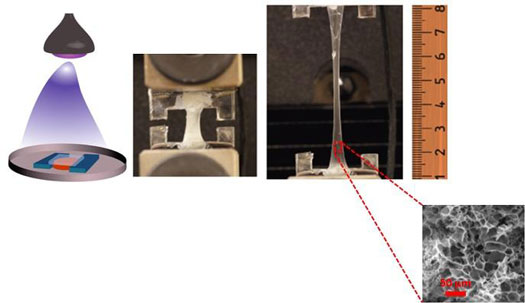| Posted: Jul 02, 2015 |
Elastic gel to heal wounds
|
|
(Nanowerk News) A team of bioengineers at Brigham and Women's Hospital (BWH), led by Ali Khademhosseini, PhD, and Nasim Annabi, PhD, of the Biomedical Engineering Division, has developed a new protein-based gel that, when exposed to light, mimics many of the properties of elastic tissue, such as skin and blood vessels. In a paper published in Advanced Functional Materials ("A Highly Elastic and Rapidly Crosslinkable Elastin-Like Polypeptide-Based Hydrogel for Biomedical Applications"), the research team reports on the new material's key properties, many of which can be finely tuned, and on the results of using the material in preclinical models of wound healing.
|
 |
| Bioengineers have developed a new protein-based gel that, when exposed to light, mimics many of the properties of elastic tissue, such as skin and blood vessels. (Courtesy of Nasim Annabi, Brigham and Women's Hospital)
|
|
"We are very interested in engineering strong, elastic materials from proteins because so many of the tissues within the human body are elastic. If we want to use biomaterials to regenerate those tissues, we need elasticity and flexibility," said Annabi, a co-senior author of the study. "Our hydrogel is very flexible, made from a biocompatible polypeptide and can be activated using light."
|
|
"Hydrogels - jelly-like materials that can mimic the properties of human tissue - are widely used in biomedicine, but currently available materials have limitations. Some synthetic gels degrade into toxic chemicals over time, and some natural gels are not strong enough to withstand the flow of arterial blood through them," said Khademhosseini.
|
|
The new material, known as a photocrosslinkable elastin-like polypeptide-based (ELP) hydrogel, offers several benefits. This elastic hydrogel is formed by using a light-activated polypeptide. When exposed to light, strong bonds form between the molecules of the gel, providing mechanical stability without the need for any chemical modifiers to be added to the material.
|
|
The team reports that ELP hydrogel can be digested overtime by naturally-occurring enzymes and does not appear to have toxic effects when tested with living cells in the lab. The team also found that they could control how much the material swelled as well its strength, finding that the ELP hydrogel could withstand more stretching than experienced by arterial tissue in the body.
|
|
"Our hydrogel has many applications: it could be used as a scaffold to grow cells or it can be incorporated with cells in a dish and then injected to stimulate tissue growth," said Annabi. "In addition, the material can be used as a sealant, sticking to the tissue at the site of injury and creating a barrier over a wound."
|
|
The researchers found that it was possible to combine the gel with silica nanoparticles - microscopic particles previously found to stop bleeding - to develop an even more powerful barrier to promote wound healing.
|
|
"This could allow us to immediately stop bleeding with one treatment," said Annabi. "We see great potential for use in the clinic. Our method is simple, the material is biocompatible, and we hope to see it solve clinical problems in the future."
|
|
Further investigation in pre-clinical models will be needed to test the material's properties and safety before approval for use in humans.
|

